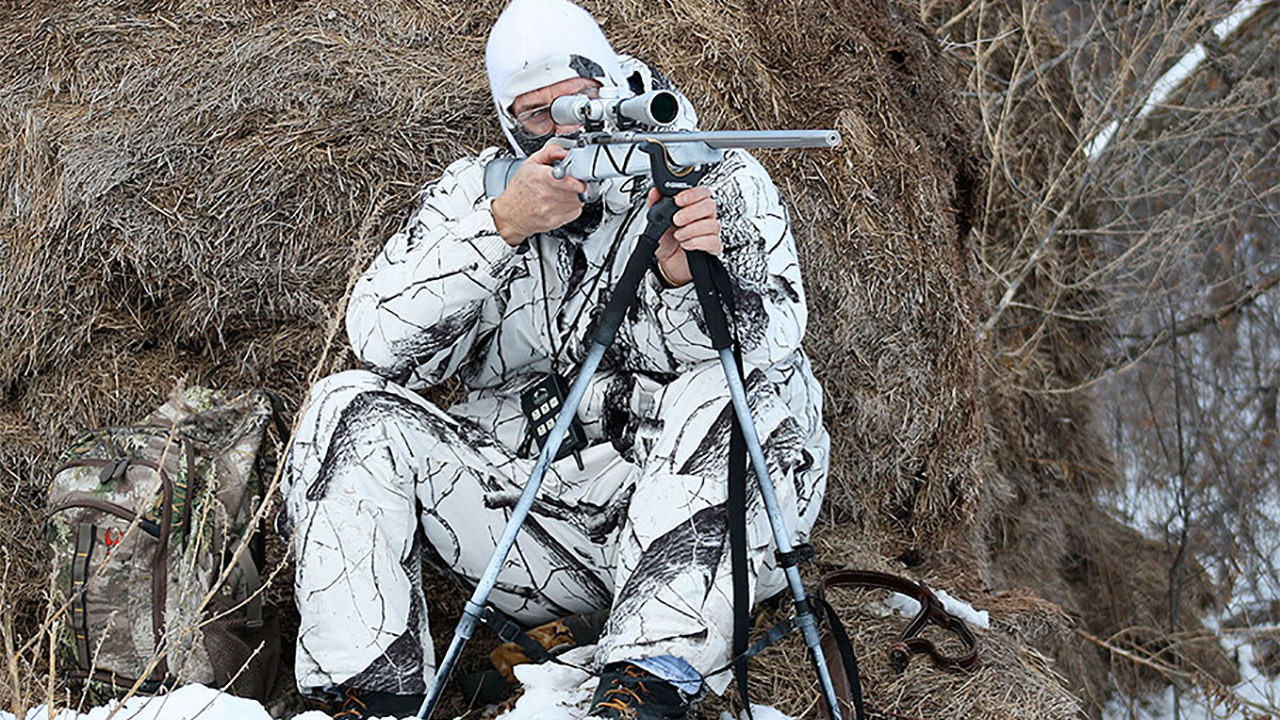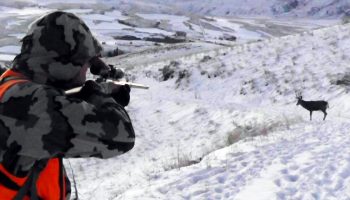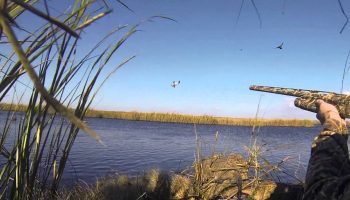Fool one of these superwary predators and you earn the rank of expert hunter. Here’s how to do it:
Focus on areas that hold small game, birds, mice, and vermin. CRP fields, brushy creek- or riverbottoms, swamps and marshes, and young clear-cuts are all excellent choices. Most farmers will gladly give you permission to hunt. Pinpoint your spots by looking for tracks and listening for barks, yips, and howls at dawn and dusk. The ideal conditions for a hunt are cold, calm days. Windy days are the worst.
Stealth is the first priority: no slamming vehicle doors or talking to your partner. Settle into a comfortable shooting position on a knoll or field edge that offers good visibility, and wait five to 15 minutes before calling.
Coyotes have extremely keen eyesight and, like any animal coming to a call, are looking hard for its source. Make sure your camo is good and that your hands and face are covered. A cushion to sit on helps you keep still.
Contents
Coyote Hunting Gear
You don’t need much to start, and you may already have it:
CALLS Mouth-operated rabbit squealers are a must, but don’t rely on them alone. Also use other distress calls and coyote howlers.
DECOYS These act as a closer to your calls. One of your kid’s beat-up stuffed animals can suffice, though battery-run motion dekes work best.
GUNS Flat-shooting rifles in .223 caliber work best in open terrain, but your deer rifle will do the trick. Shot-guns rule in thick timber or on night hunts (where legal). If you hunt turkeys, you probably already own the right setup: a tight-choked 12-gauge that throws a dense pattern out to 35 yards. Use No. 4 buckshot in magnum loads.
Tips for Calling in More Coyotes
Practice What You Preach
Electronic calls are great. So are hand calls. But neither will come easy to you. They take practice.
“If you’re hand calling, get out and do it,” Belding said. “The best teacher is doing it yourself and failing. If something doesn’t work, try something a little different. Then you’ll know what works for you in your area. It’s different depending on terrain, prey, and other factors.”
Walk Into The Wind
Coyotes have exceptional noses. They’re canines. And canines are infamous for their ability to sniff things out, including people. That has to not only be considered but also dwelled upon in order to be consistently successful.
“Keep the wind in your face,” South said. “You can’t call a coyote that knows you’re there.”
Pick A Vantage Point
“Pick a vantage point where you can see the coyote when it responds to your call,” South said.
You can’t kill something you can’t see. The only way to make sure you see approaching coyotes is to get somewhere you can. Get up high on a hill, or somewhere else where you can see the landscape around you. The last thing you want is a coyote sneaking within a few yards of you and not even realize it’s there.
From Stand To Stand
Give each stand 20 to 30 minutes to produce. Most times, coyotes will respond within the first five minutes. But that isn’t always the case. Give each stand time to work.
“Typically, in our neck of the woods (Reno, Nevada), we go ¾ of a mile to a mile between calling setups,” Belding said. “But on windy days—working into the wind so they don’t smell you—you can set up more frequently and get close to them. They can’t hear you coming. You can use this to your advantage.”
For those hunting in the eastern states, you also can set up a little more frequently. Rolling hills, dense cover and other factors prevent sounds—and calls—from traveling quite as far. That’s something to consider when choosing stand locations.
Mistakes Rookie Coyote Hunters Make
No matter how many times you watch the coyote-killing team on video, you just can’t figure out how to duplicate their success. While those guys seem to bring coyotes running to the gun every time they make a rabbit squeal, you’ve only managed to call in a few crows and one stray dog looking for an easy meal. You’ve spent a few months’ worth of rent on rifles, lights and calls. You’re developing tinnitus from listening to the scream of a dying rabbit over and over. And, still, you haven’t gotten a single ‘yote to show for your efforts.
You’re Hunting Where There Are No Coyotes
You might be surprised at how often this happens.
Unlike deer hunters who scout for months in search of a big buck, coyote hunters have a tendency to say, “They should be here” and set up in an area where there may or may not be many coyotes.
Hunting in an area that is nearly void of coyotes is a big waste of time and energy. Scouting helps you to avoid that trap. Look for tracks, kill sites and scat, and it’s not a bad idea to pay attention to coyote vocalizations to determine where they call home. It’s well worth a few hours of your time to greatly up the odds of success when you’re hunting. Once you do find an area with coyotes, don’t run them all off with a sloppy approach to your calling setup.
You’re Using the Wrong Call
Coyotes don’t just come running any time they hear something that sounds like a dinner bell.
“With all the coyote hunters out there it’s hard to find a mature dog that hasn’t been called to,” says Realtree pro-staffer and predator hunting expert Fred Eichler. “Many are educated and often turn tail and run when they hear the common sounds used by most coyote hunters. By using the calls coyotes haven’t heard, or that aren’t commonly used, a new caller will have more success. I often use bird calls like a turkey in distress or woodpecker distress or I use fawn bleats or puppy screams to bring in call-shy dogs.”
For newcomers, coyote hunting guru Mark Zepp recommends an electronic caller.
“The reliability of today’s electronic calls make it easy for anyone to go out and give it a try without worrying whether or not they are making a correct sound with a hand call,” he says.
You’re Calling Too Much or Too Little
This is an area of great debate among serious coyote hunters. Calling too much can warn off a curious coyote, but calling too little or too softly may not entice a distant coyote to break cover.
As a general rule, open areas require louder, longer calling sequences. But be careful. A loud, long string of calls may scare away incoming coyotes in high-pressure areas.
This is one of those mistakes that only experience can remedy. Keep notes on how you call in certain areas and what the outcomes were. Over time, you’ll start to identify patterns that worked. And ones that didn’t.
You’re Giving Up Too Soon
A common mistake, according to Eichler, is giving up on a set too soon.
“Whether I am calling in Florida or Canada I sit a minimum of 30 minutes,” he says. “The only exception is if it’s snowing, raining or really windy and I know the call isn’t carrying as far. On a calm day or with a 10-mile-per hour wind or less, I have a lot of coyotes come in after 20 minutes. A lot of newbies are packing it up by then.”
Give your calling location enough time to work. A good rule of thumb is to wait 30 minutes before moving on.
You’re Hunting Pressured Dogs
So let’s wrap this up. Hard-hunted coyotes are smart coyotes. Why? Because the dumb ones are already dead.
If you’re a newcomer and have spent some time calling, odds are good you’ve made one of the mistakes listed above and educated coyotes. But don’t worry too much about that — even if you didn’t, odds are good someone else did.
Coyotoes living in heavily-hunted areas are harder to hunt. That’s just the way it is. But by following the advice you’ve just been given and doing what you can to hunt smart, you can turn the tide.
Heavily-hunted coyotes aren’t going to fall for the same song and dance that every other hunter in the woods is throwing their way. Be innovative. Try different calls, keep it subtle and keep it smart.






